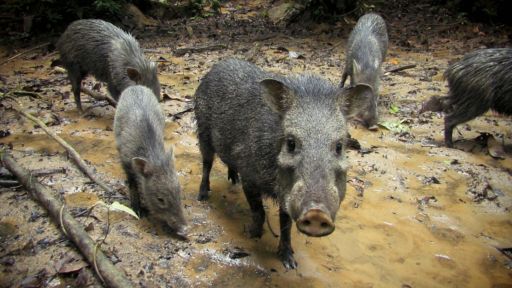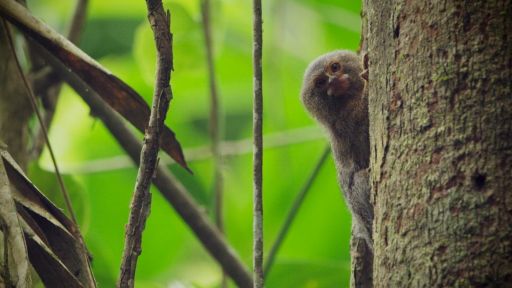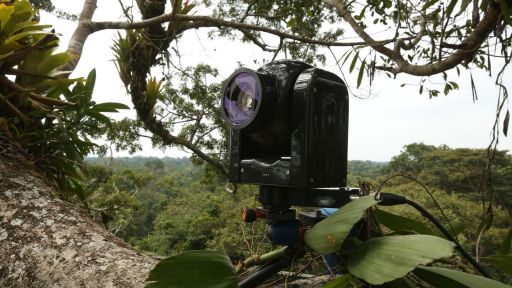Go behind the scenes to see even more of the challenges the production team overcame in making Undercover in the Jungle.
Features



- [Narrator] Our mission, to take a rig of remotely operated cameras and install them into one of the wildest rain forests on Earth, would be a film making challenge like no other.
(intense music) The journey to the filming site took four days, pressing deeper and deeper into the Ecuadorian Amazon.
Despite it being the dry season, we were already getting a taste of the unforgiving conditions we'd be up against.
Tired and wet, we finally arrived at our filming location.
Home for the next month.
(water running) Set on the banks of a small tributary, this area of pristine jungle is completely isolated.
Not a place we could get spares if any of our camera equipment went down.
- It's just so hot, so wet.
It's rained all night long.
So we've been kind of walking through extremes just to get to the site.
The sweat bees are having a field day, trying to get into all of our eyes and noses and ears, and it's beautiful and I love it.
With the help of our local guides, our first task was to locate the key sites to place our cameras.
We want to make sure we've got as much coverage in this clearing as possible.
- Do you think if we got a camera there and a camera there, it makes sense to have a high camera on a different tree, just so we have another angle?
- You could, yeah, get a ladder up there.
- And we could use, we could have a camera kind of right back against this tree here, so it's not going to get knocked by anything.
- [Narrator] We wanted to find the paths the animals used through the jungle.
- I think this is the root that the monkeys tend to come down.
You can see all these branches are covered in mud like I've been climbing on them.
- [Narrator] As well as the places they go to feed.
- There's two big trees over here which got loads of fruit on them which aren't ripe yet, but I think they're going to be drawing a lot of wild life in the coming weeks when they ripen.
- [Narrator] With only a month to get the footage we needed, we had to find areas that multiple animals visit daily to increase our chances of capturing the most interesting behaviors.
- Let's work out where our box should go.
- [Narrator] One potentially fruitful spot that we discovered was a flooded clearing.
- Pretty much every animal requires salt in their diet.
These solidaras, these mineral licks are kind of key areas where they can get that, so over years, probably hundreds of different species come in, they churn up the mud, they eat around at the banks, kind of creates these big wallows, and in a place like the Amazon, which is so enclosed, the trees are so thick and you get so little light, apart from places like this, these are the kind of real key spots where you see amazing wildlife action.
- [Narrator] In order for us to capture the behaviors of as many varied species as possible, we needed to fix cameras in a broad range of habitats.
From caves, to well worn animal trails, high up in a canopy, and along the banks of the river.
- We've got some pretty special equipment to film here.
Which is a remote camera so we can put multiple cameras in one place, we can get multiple angles.
We can be close to the animals without disturbing them.
It's a very new and exciting way to capture wildlife.
You know the wildlife here is really smart, amazing sense of smell, rubber cables.
We've got to try and disguise the smells and the shapes of these things as much as possible.
So covering it with leaves, covering it with mud.
- A country ripple is it you wanted?
It's not a bad place to hide cables in the sense that there are just creepers and vines just kind of everywhere - It's hard to know we've laid a camera sometimes.
You go into the cave entrance down there, where you've neatly cut the cables into the side of that wall, plastered it over.
I thought we still needed the cables in down there.
- [Narrator] The cameras we use capture a 360 view of their surroundings, and can tilt and zoom to capture the wildlife.
All controlled remotely.
But connecting power and getting video links from multiple cameras was a huge task, and the tough conditions of the Amazon Rainforest called for some even tougher equipment.
- So all of our cameras are going to be connected with this essentially military grade fiber optic cable.
It's rodent proof, it's water proof, it's ant and insect proof, and it's super light as well.
So this is amazing.
This allows us to have our camera base several hundred meters away from the cameras so that we're gonna be in a place where we're not going to disturb any of these animals and be able to monitor them without altering their behavior.
- [Narrator] Over the month we installed more than 6000 feet of cables to connect our cameras, infrared lights, and batteries, all feeding back to our remote monitoring stations, from where we could film the action as it unfolded.
And after the huge technical challenge of rigging this entire area of jungle, we could now begin the even bigger task of using our network of cameras to try and film the intimate lives of the animals here.
- Wow what a remarkable moment to have captured.
(wondrous music)
